Measurement of M2-Curve for Asymmetric Beams by Self-Referencing Interferometer Wavefront Sensor
Abstract
:1. Introduction
2. Self-Referencing Interferometer Wavefront Sensor
2.1. Experiment Setup of SRI-WFS
2.2. Reconstruction of Complex Amplitude Field
3. Determination of M2-Curve
3.1. Measurement Method for Beam Quality Factor M2 Based on the Complex Amplitude Distribution [24]
3.2. M2-Curve
4. Experiment Results and Discussions
5. Conclusions
Acknowledgments
Author Contributions
Conflicts of Interest
References
- Siegman, A.E. New developments in laser resonators, in Optical Resonators. Proc. SPIE 1990, 1224, 2–14. [Google Scholar]
- Siegman, A.E. Defining, measuring, and optimizing laser beam quality. Proc. SPIE 1993, 1868, 2–13. [Google Scholar]
- International Standardization for Standardization. Terminology and Test Methods ISO/TC172/SC/WG1; ISO: Geneva, Switzerland, 1991. [Google Scholar]
- International Standardization for Standardization. ISO 11146-1 Lasers and Laser-Related Equipment—Test Methods for Laser Beam Widths, Divergence Angles and Beam Propagation Ratios—Part 1: Stigmatic and Simple Astigmatic Beams; ISO: Geneva, Switzerland, 2005. [Google Scholar]
- International Standardization for Standardization. ISO 11146-2, Lasers and Laser-Related Equipment—Test Methods for Laser Beam Widths, Divergence Angles and Beam Propagation Ratios—Part 2: General Astigmatic Beams; ISO: Geneva, Switzerland, 2005. [Google Scholar]
- International Standardization for Standardization. ISO 11146-3, Lasers and Laser-Related Equipment—Test Methods for Laser Beam Widths, Divergence Angles and Beam Propagation Ratios—Part 3: Intrinsic and Geometrical Laser Beam Classification, Propagation and Details of Test Methods; ISO: Geneva, Switzerland, 2004. [Google Scholar]
- Bouafia, M.; Bencheikh, H.; Bouamama, L.; Weber, H. M2 quality factor as a key to mastering laser beam propagation. Proc. SPIE 2004, 5456, 130–140. [Google Scholar]
- Paschotta, R. Beam quality deterioration of lasers caused by intracavity beam distortions. Opt. Express 2006, 14, 6069–6074. [Google Scholar] [CrossRef] [PubMed]
- Feng, G.-Y.; Zhou, S. Discussion of comprehensive evaluation on laser beam quality. Chin. J. Laser 2009, 36, 1643–1653. [Google Scholar]
- Newburgh, G.A.; Michael, A.; Dubinskii, M. Composite Yb:YAG/SiC-prism thin disk laser. Opt. Express 2010, 18, 17066–17074. [Google Scholar] [CrossRef] [PubMed]
- Borgentun, C.; Bengtsson, J.; Larsson, A. Full characterization of a high-power semiconductor disk laser beam with simultaneous capture of optimally sized focus and far-field. Appl. Opt. 2011, 50, 1640–1649. [Google Scholar] [CrossRef] [PubMed]
- Xiang, Z.; Wang, D.; Pan, S.; Dong, Y.; Zhao, Z.; Li, T.; Ge, J.; Liu, C.; Chen, J. Beam quality improvement by gain guiding effect in end-pumped Nd:YVO4 laser amplifiers. Opt. Express 2011, 19, 21060–21073. [Google Scholar] [CrossRef] [PubMed]
- Scaggs, M.; Haas, G. Real time monitoring of thermal lensing of a multikilowatt fiber laser optical system. In Proceedings of the Laser Resonators, Microresonators, and Beam Control XIV, San Francisco, CA, USA, 22–25 January 2012.
- Gong, M.L.; Qiu, Y.; Huang, L.; Liu, Q.; Yan, P.; Zhang, H.T. Beam quality improvement by joint compensation of amplitude and phase. Opt. Lett. 2013, 38, 1101–1103. [Google Scholar] [CrossRef] [PubMed]
- Schäfer, B.; Mann, K. Determination of beam parameters and coherence properties of laser radiation by use of an extended Hartmann-Shack wave-front sensor. Appl. Opt. 2002, 41, 2809–2817. [Google Scholar] [CrossRef] [PubMed]
- Schäfer, B.; Lübbecke, M.; Mann, K. Hartmann-Shack wave front measurements for real time determination of laser beam propagation parameters. Rev. Sci. Instrum. 2006, 77, 053103. [Google Scholar] [CrossRef]
- Neubert, B.J.; Huber, G.; Scharfe, W. On the problem of M2 analysis using Shack-Hartmann measurements. J. Phys. D Appl. Phys. 2001, 34, 2414–2419. [Google Scholar] [CrossRef]
- Sheldakova, J.V.; Kudryashov, A.V.; Zavalova, V.Y.; Cherezova, T.Y. Beam quality measurements with Shack-Hartmann wavefront sensor and M2-sensor: Comparison of two methods. In Proceedings of the Laser Resonators and Beam Control IX, San Jose, CA, USA, 22–24 January 2007.
- Lambert, R.W.; Cortés-Martínez, R.; Waddle, A.J.; Shephard, J.D.; Taghizadeh, M.R.; Greenaway, A.H.; Hand, D.P. Compact optical system for pulse-to-pulse laser beam quality measurement and applications in laser machining. Appl. Opt. 2004, 43, 5037–5046. [Google Scholar] [CrossRef] [PubMed]
- Schmidt, O.A.; Schulze, C.; Flamm, D.; Brüning, R.; Kaiser, T.; Schröoter, S.; Duparré, M. Real-time determination of laser beam quality by modal decomposition. Opt. Express 2011, 19, 6741–6748. [Google Scholar] [CrossRef] [PubMed]
- Flamm, D.; Schulze, C.; Brüning, R.; Schmidt, O.A.; Kaiser, T.; Schröter, S.; Duparré, M. Fast M2 measurement for fiber beams based on modal analysis. Appl. Opt. 2012, 51, 987–996. [Google Scholar] [CrossRef] [PubMed]
- Schulze, C.; Flamm, D.; Duparré, M.; Forbes, A. Beam-quality measurements using a spatial light modulator. Opt. Lett. 2012, 37, 4867–4869. [Google Scholar] [CrossRef]
- Offerhaus, H.L.; Edwards, C.B.; Witteman, W.J. Single shot beam quality (M2) measurement using a spatial Fourier transform of the near field. Opt. Commun. 1998, 151, 65–68. [Google Scholar] [CrossRef]
- Du, Y.-Z.; Feng, G.-Y.; Li, H.; Cai, Z.; Zhao, H.; Zhou, S. Real-time determination of beam propagation factor by Mach-Zehnder point diffraction interferometer. Opt. Commun. 2013, 287, 1–5. [Google Scholar] [CrossRef]
- Feldman, M.; Mockler, D.J.; English, R.E.; Byrd, J.L., Jr.; Salmon, J.T. Self-referencing Mach-Zehnder interferometer as a laser system diagnostic. In Proceedings of the Active and Adaptive Optical Systems, San Diego, CA, USA, 22–24 July 1991.
- Rhoadarmer, T.A. Development of a self-referencing interferometer wavefront sensor. Proc. SPIE Adv. Wavefront Control Methods Devices Appl. II 2004, 5553, 112–126. [Google Scholar]
- Nemes, G.; Siegman, A.E. Measurement of all ten second-order moments of an astigmatic beam by the use of rotating simple astigmatic (anamorphic) optics. J. Opt. Soc. Am. A 1994, 11, 2257–2263. [Google Scholar] [CrossRef]
- Kochkina, E.; Wanner, G.; Schmelzer, D.; Tröbs, M.; Heinzel, G. Modeling of the general astigmatic Gaussian beam and its propagation through 3D optical systems. Appl. Opt. 2013, 52, 6030–6040. [Google Scholar] [CrossRef] [PubMed]
- Deng, G.; Feng, G.; Li, W.; Zhang, T.; Liao, H.; Zhou, S. Experimental study of beam quality factor M2 matrix for non-circular symmetry beam. Chin. J. Laser 2009, 36, 2014–2018. [Google Scholar] [CrossRef]
- Li, W.; Feng, G.; Huang, Y.; Deng, G.; Huang, Y.; Chen, J.; Zhou, S. Matrix formulation of the beam quality of the Hermite-Gaussian beam. Laser Phys. 2009, 19, 1–6. [Google Scholar] [CrossRef]
- Li, W.; Feng, G.-Y.; Huang, Y.; Li, G.; Yang, H.-M.; Xie, X.-D.; Chen, J.-G.; Zhou, S.-H. M2 factor matrix for two-dimensional Hermite-Gaussian beam. Acta Phys. Sin. 2009, 58, 2461–2466. [Google Scholar]
- Liu, X.-L.; Feng, G.-Y.; Li, W.; Tang, C.; Zhou, S.-H. Theoretical and experimental study on M2 factor matrix for astigmatic elliptical Gaussian beam. Acta Phys. Sin. 2013, 62, 194202. [Google Scholar]
- Takeda, M.; Ina, H.; Kobayashi, S. Fourier transform method of fringe pattern analysis for computer-based topography and interferometry. J. Opt. Soc. Am. 1982, 72, 156–160. [Google Scholar] [CrossRef]
- Kohler, D.R.; Gamiz, V.L. Interferogram reduction for radial-shear and local-reference-holographic interferograms. App. Opt. 1986, 25, 1650–1652. [Google Scholar] [CrossRef]
- Notaras, J.; Paterson, C. Demonstration of closed-loop adaptive optics with a point-diffraction interferometer in strong scintillation with optical vortices. Opt. Express 2007, 15, 13745–13756. [Google Scholar]
- Notaras, J.; Paterson, C. Point-diffraction interferometer for atmospheric adaptive optics in strong scintillation. Opt. Commun. 2008, 281, 360–367. [Google Scholar] [CrossRef]
- Goodman, J.W. Introduction to Fourier Optics, 2nd ed.; McGraw-Hill: New York, NY, USA, 1968; pp. 63–90. [Google Scholar]
- Smartt, R.N.; Stell, W.H. Theory and Application of Point-Diffraction Interferometers. Jpn. J. Appl. Phys. 1975, 14, 351–356. [Google Scholar] [CrossRef]
- Koliopoulos, C.; Kwon, O.; Shagam, R.; Wyant, J.C.; Hayslett, C.R. Infrared point-diffraction interferometer. Opt. Lett. 1978, 3, 118–120. [Google Scholar] [CrossRef] [PubMed]
- Mercer, C.R.; Creath, K. Liquid-crystal point-diffraction interferometer for wave-front measurement. Appl. Opt. 1996, 35, 1633–1642. [Google Scholar] [CrossRef] [PubMed]
- Lago, E.L.; dela Fuente, R. Amplitude and phase reconstruction by radial shearing interferometry. Appl. Opt. 2008, 47, 372–377. [Google Scholar] [CrossRef]
- Bone, D.J.; Bachor, H.-A.; Sandeman, R.J. Fringe-pattern analysis using a 2-D Fourier transform. Appl. Opt. 1986, 25, 1653–1660. [Google Scholar] [CrossRef] [PubMed]
- Roddier, C.; Roddier, F. Interferogram analysis using Fourier transform techniques. Appl. Opt. 1987, 26, 1668–1673. [Google Scholar] [CrossRef] [PubMed]
- Mendlovic, D.; Zalevsky, Z.; Konforti, N. Computation considefactorns and fast algorithms for calculating the diffraction integral. J. Mod. Opt. 1997, 44, 407–414. [Google Scholar] [CrossRef]
- Kogelnik, H.; Li, T. Laser beams and resonators. Appl. Opt. 1996, 5, 1550–1567. [Google Scholar] [CrossRef] [PubMed]
- Siegman, A.E. Lasers; University Science Books: Mill Valley, CA, USA, 1986; pp. 777–811. [Google Scholar]
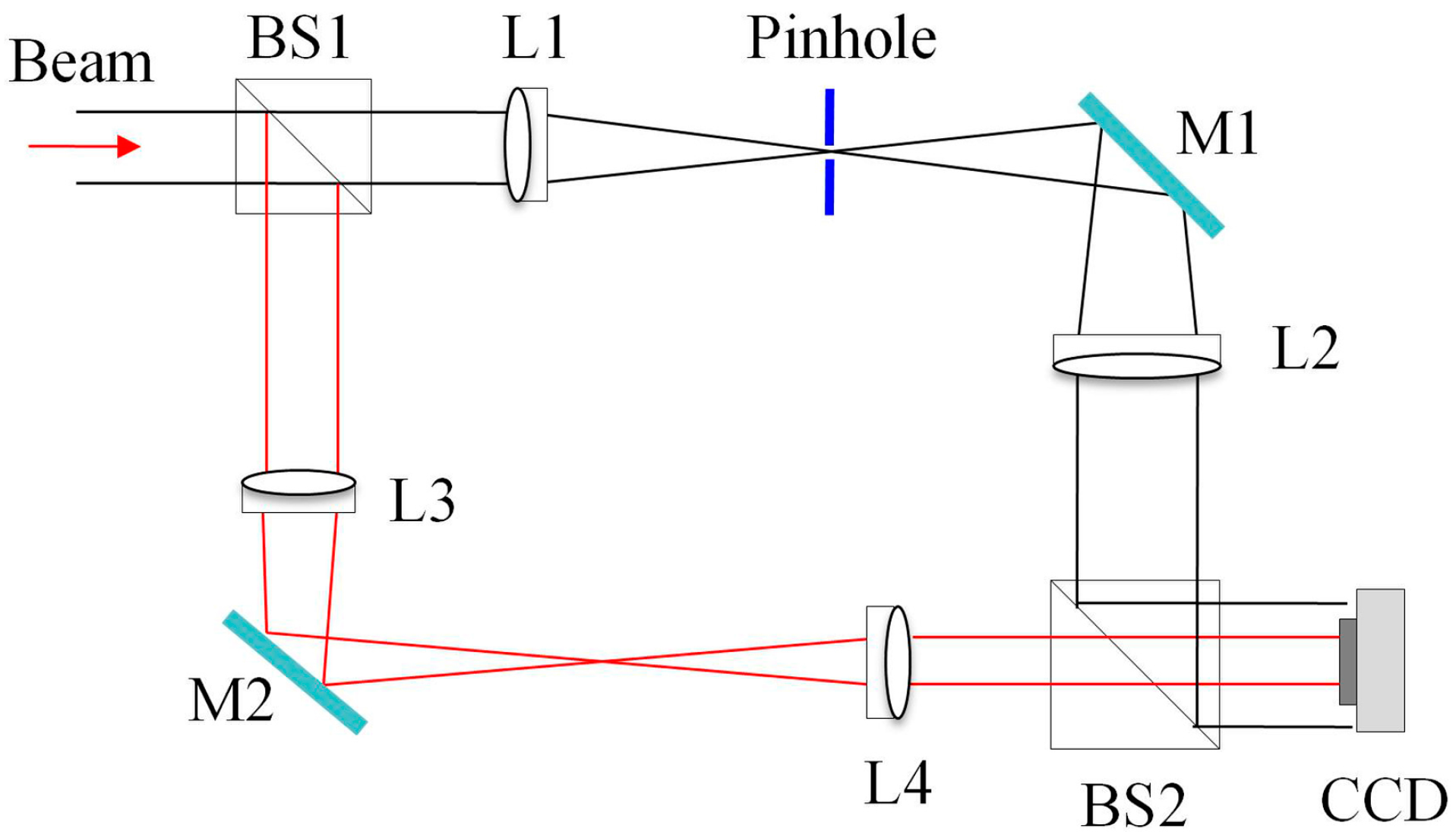
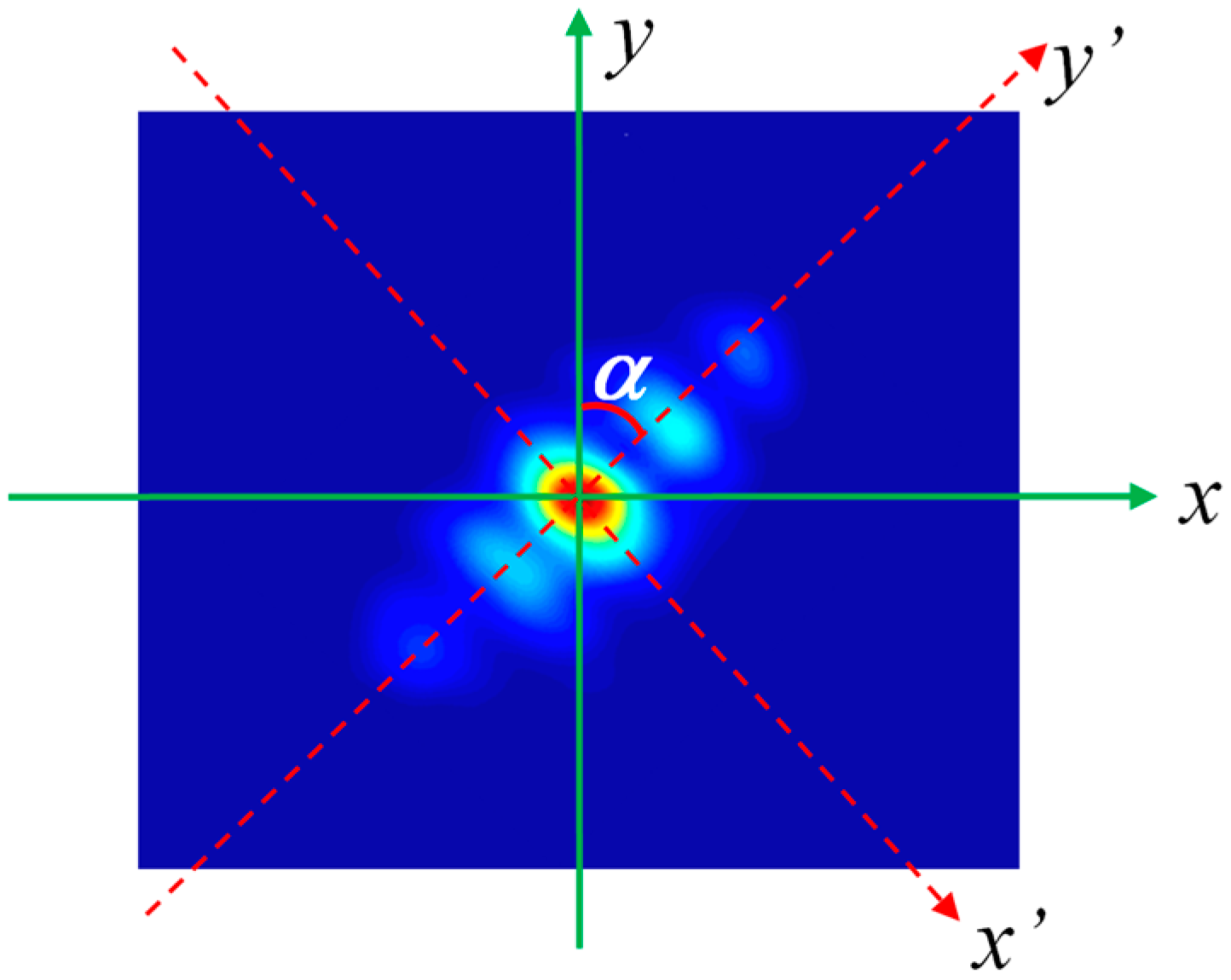



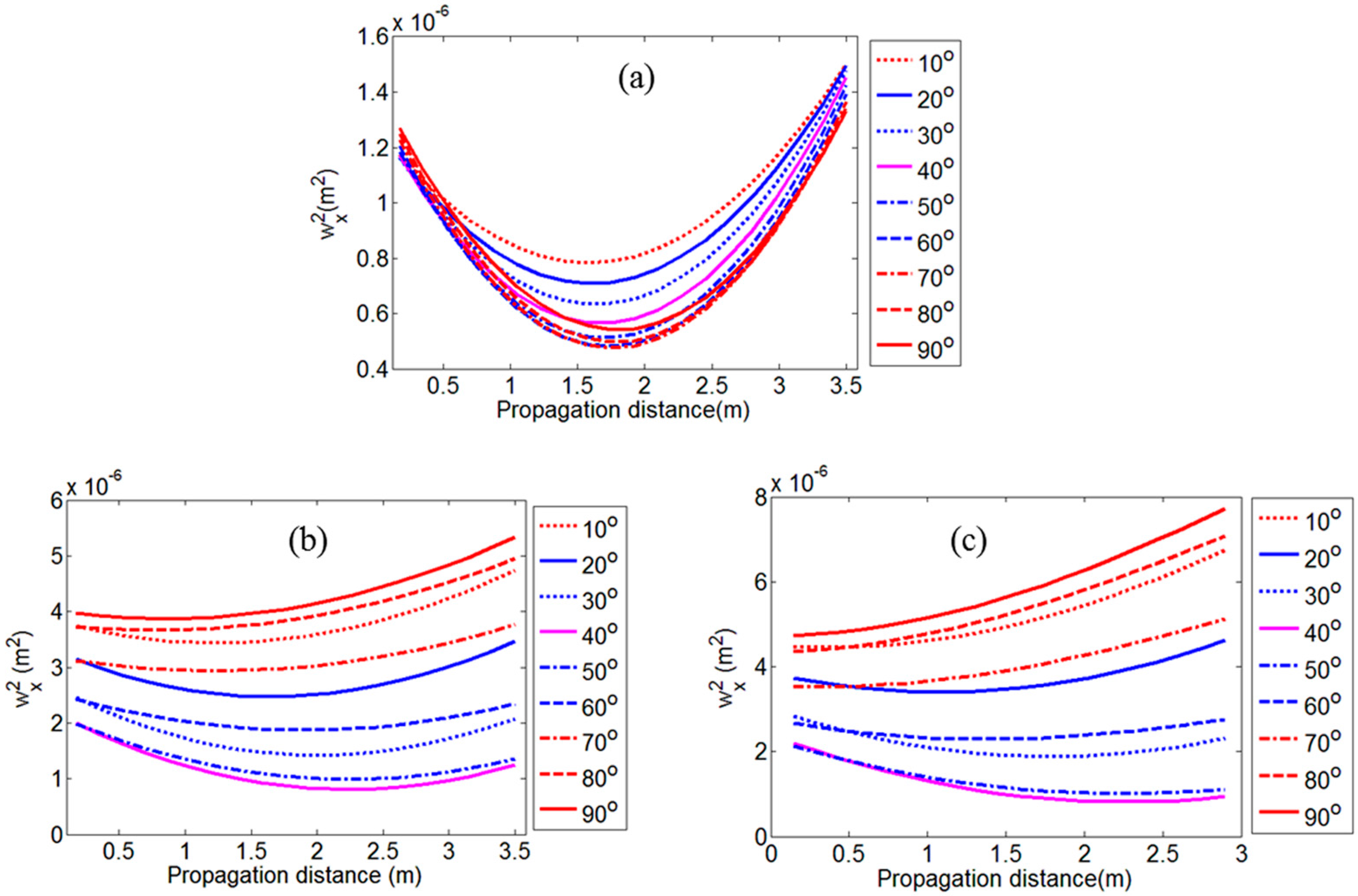
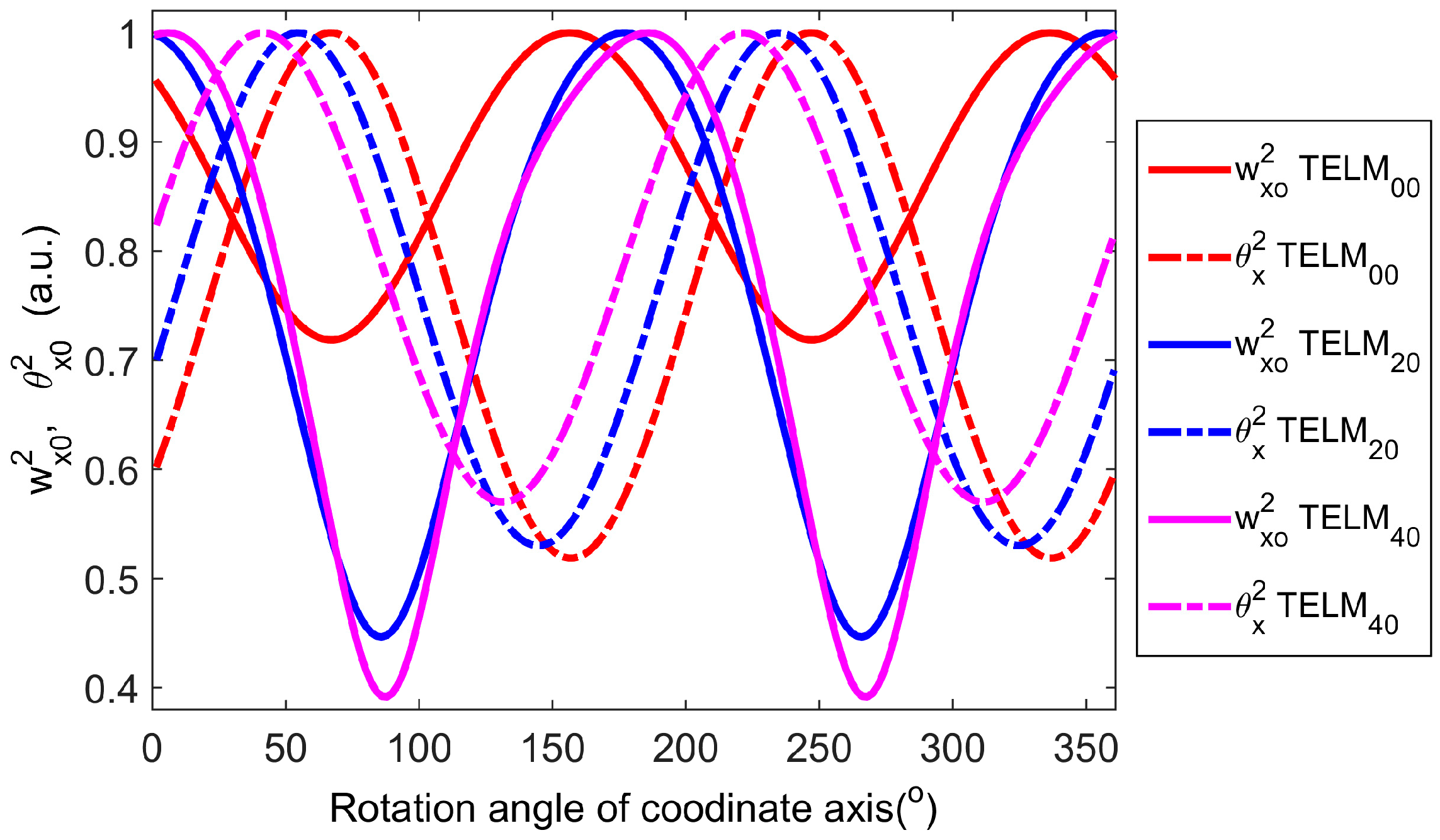
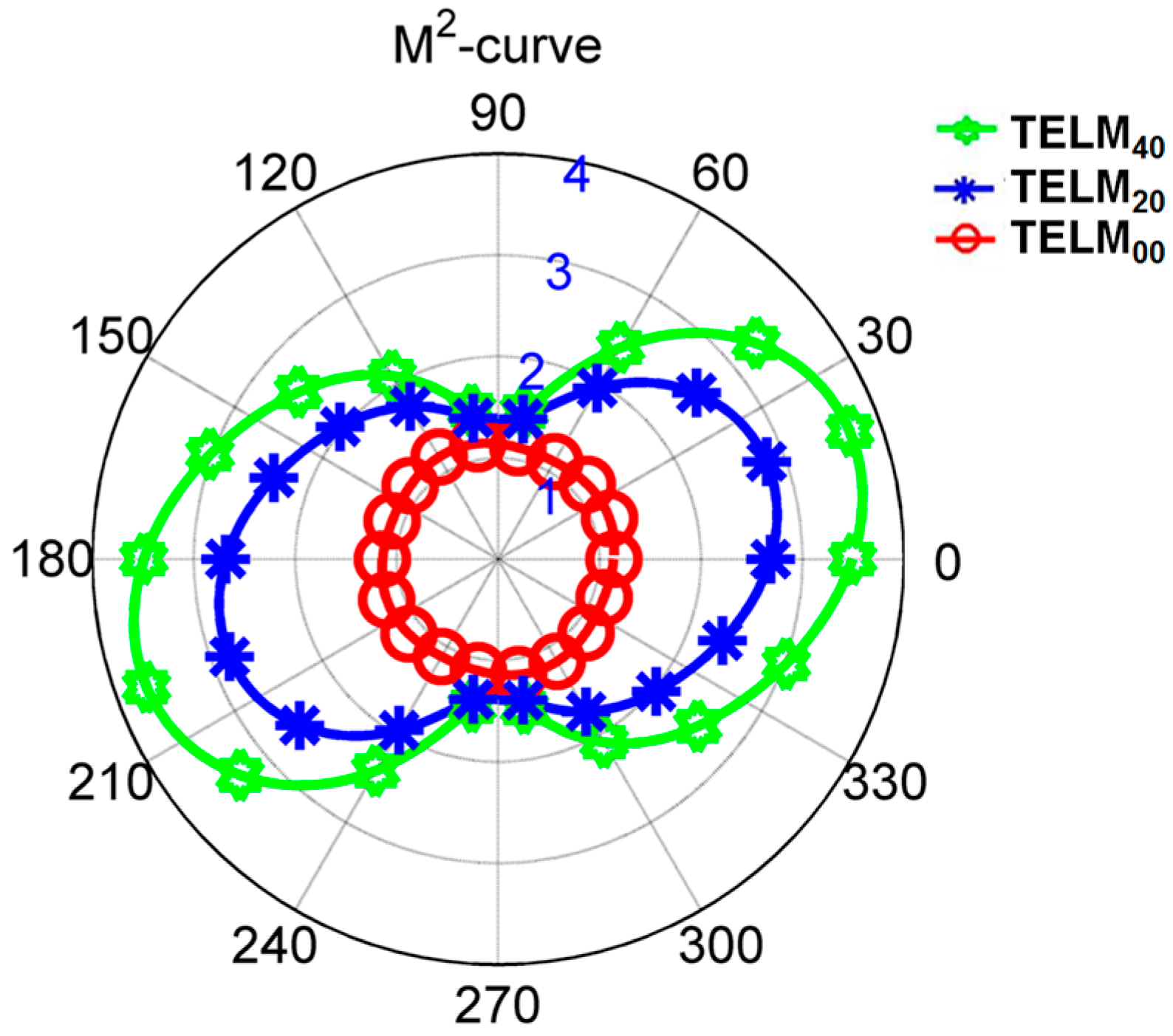
| Beam Quality | ||||||
|---|---|---|---|---|---|---|
| TELM00 | TELM20 | TELM40 | TELM00 | TELM20 | TELM40 | |
| SRI-WFS | 1.06 | 2.62 | 3.72 | 1.08 | 1.27 | 1.37 |
| ISO1116 method | 1.04 | 2.54 | 3.56 | 1.06 | 1.20 | 1.32 |
| Errors (%) | 1.96% | 3.15% | 4.49% | 1.89% | 5.83% | 3.79% |
© 2016 by the author; licensee MDPI, Basel, Switzerland. This article is an open access article distributed under the terms and conditions of the Creative Commons Attribution (CC-BY) license (http://creativecommons.org/licenses/by/4.0/).
Share and Cite
Du, Y. Measurement of M2-Curve for Asymmetric Beams by Self-Referencing Interferometer Wavefront Sensor. Sensors 2016, 16, 2014. https://doi.org/10.3390/s16122014
Du Y. Measurement of M2-Curve for Asymmetric Beams by Self-Referencing Interferometer Wavefront Sensor. Sensors. 2016; 16(12):2014. https://doi.org/10.3390/s16122014
Chicago/Turabian StyleDu, Yongzhao. 2016. "Measurement of M2-Curve for Asymmetric Beams by Self-Referencing Interferometer Wavefront Sensor" Sensors 16, no. 12: 2014. https://doi.org/10.3390/s16122014





